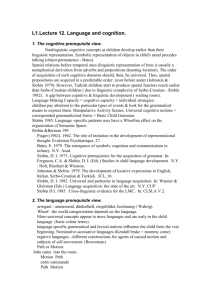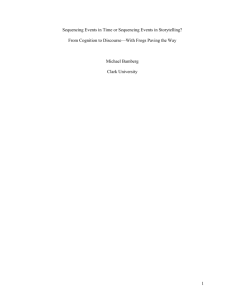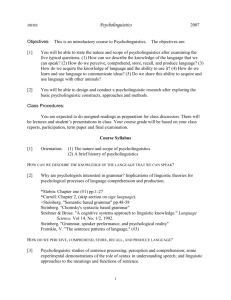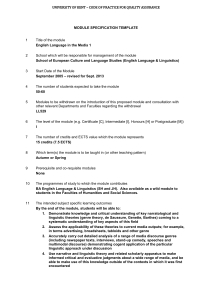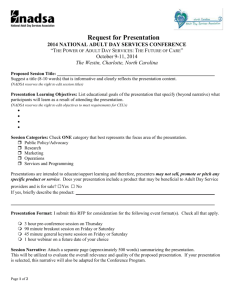This chapter is a short contribution to a volume that
advertisement
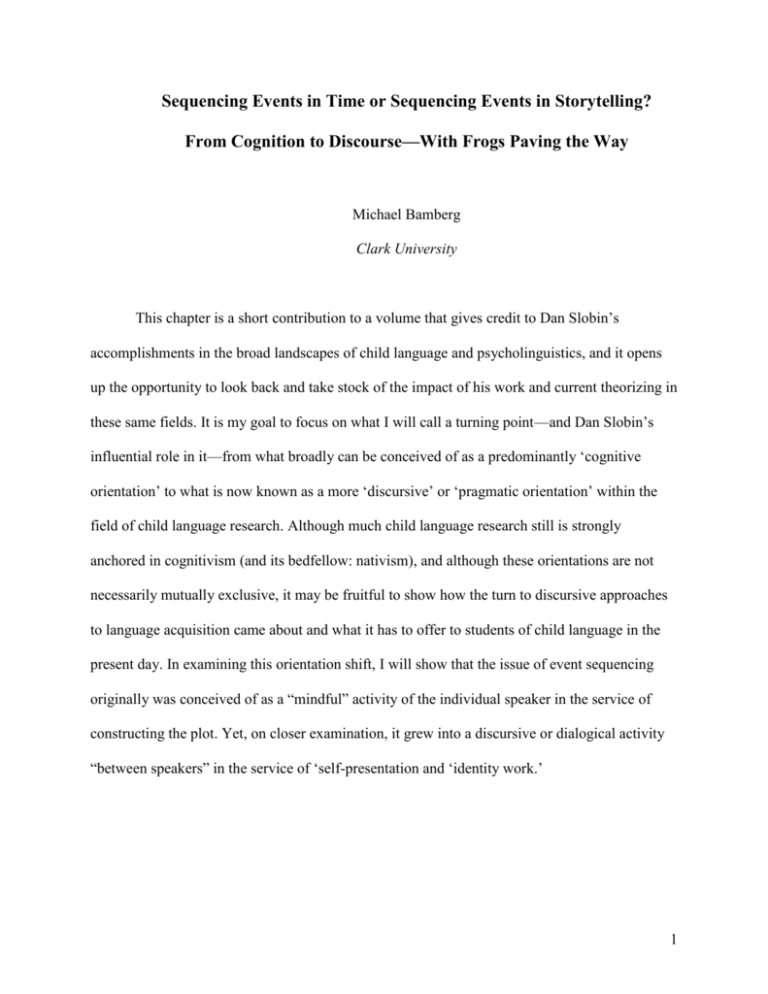
Sequencing Events in Time or Sequencing Events in Storytelling? From Cognition to Discourse—With Frogs Paving the Way Michael Bamberg Clark University This chapter is a short contribution to a volume that gives credit to Dan Slobin’s accomplishments in the broad landscapes of child language and psycholinguistics, and it opens up the opportunity to look back and take stock of the impact of his work and current theorizing in these same fields. It is my goal to focus on what I will call a turning point—and Dan Slobin’s influential role in it—from what broadly can be conceived of as a predominantly ‘cognitive orientation’ to what is now known as a more ‘discursive’ or ‘pragmatic orientation’ within the field of child language research. Although much child language research still is strongly anchored in cognitivism (and its bedfellow: nativism), and although these orientations are not necessarily mutually exclusive, it may be fruitful to show how the turn to discursive approaches to language acquisition came about and what it has to offer to students of child language in the present day. In examining this orientation shift, I will show that the issue of event sequencing originally was conceived of as a “mindful” activity of the individual speaker in the service of constructing the plot. Yet, on closer examination, it grew into a discursive or dialogical activity “between speakers” in the service of ‘self-presentation and ‘identity work.’ 1 Let me start with a brief historical introduction of how the language acquisition task was conceived of at the height of the cognitive revolution.1 In the early sixties (1960-64), Dan Slobin was a student at the Harvard Center for Cognitive Studies and took classes with Roger Brown, Eric Lenneberg, George Miller, and Jerry Bruner. He also ventured down to the MIT campus to audit a Chomsky seminar. So it comes as no surprise that his early notions of the language acquisition task were framed in terms of innate concepts and the child’s cognitive advances jointly impinging on meaningful concepts that became mapped onto linguistic forms in the child’s linguistic development. While on one hand, Slobin’s assumptions were in agreement with Chomsky’s position that all languages have the same basic underlying structure and that humans operate with the same basic cognitive principles, his 1973 proposal of Operating Principles constituted a considerable departure from a strong deterministic nativist position. He posited that the child is equipped with cognitive predispositions or preferences to figure out how meanings can be mapped on to linguistic units. In order to do so, he needed to attend to the language specificity of the language with which the child grew up. More specifically, Slobin defined the language acquisition task as learning to connect two aspects of language: the content aspect and the relational aspect. The content aspect was said to consist of the ability to refer to objects and events of experience, while the relational aspect highlighted the connection of these objects and events with one another. The first was said to take place typically in the form of lexical items or content words, while the second was accomplished by grammatical functors. Both interacted differently in different languages, particularly in typologically different languages, and Slobin claimed it was the child’s task to figure out the ways his/her mother tongue split up the divide. More specifically, the child needed Of course, any compilation of “historical facts” is not only retrospective but also from an ideological vantage point. My own is that of a ‘dicursive psychologist’. 1 2 to attend to the kinds of systematic form-function relationships. Later on (1997/2001), Slobin more strongly emphasized a third component to be equally relevant for the language acquisition task. It consisted of another relational orientation, namely, to view the objects and events of experience from the speaker’s discourse perspective. In my contribution to this volume I will take off from this formulation of the relationship between content and how content items are related with each other and how both of them in concert orienting towards the discourse perspective of the speaker. I will use the frog-book project to show how an originally cognitive orientation to the language acquisition task that was mainly interested in children’s grammatical marking of sequencing events in time could turn subversively into something much larger. However, before I head this way, let me briefly summarize the view of the child that was running parallel to this type of theorizing. It was very clear, from early on, that the child was somewhat of an agent in the process of conducting the learning task. The child had to figure out the language specific intricacies all by him/herself—albeit with the kind of cognitive equipment they were developing, which in turn was assumed to be nested within the processes of a universal cognitive development. Thus, the course of the child’s general development proceeds from their mental development to their linguistic development, placing the language learning task squarely within the domain of the child’s cognitive development. Again, it comes as no surprise that, within this general framework of setting up the task of ‘cracking the linguistic code,’ the child’s social development was consistently reduced to the right exposure to the right input that the well-equipped mind subsequently could process “actively” into the right linguistic knowledge. In sum, it appeared as though Jerry Bruner’s influence in Dan Slobin’s early stages of developing “Basic Child Grammars” in solving the puzzle of how meanings become mapped onto linguistic forms was 3 minimal. Still, fast forwarding to Slobin’s more recent formulations of the language acquisition task, which frame the child as “learning to think for speaking and to listen for understanding in terms of the exposure language(s)” (2001), these formulations equally give little space to the child’s active explorations in their everyday language practices. Rather, the language itself comes to organize the child’s language practices along the underlying typology of the target language (Slobin, 1997/2001). Thus, what still sounds like a very cognitive solution of the language acquisition task, one that pays little attention to children’s active role in the making of grammatical structures, nevertheless attempts to give language a major role in children’s cognitive socialization. I will return later to potential implications of this perspective. The Frog-Book Project: From ‘Relating Events in Time’ to ‘Relating Events in Narrative’ The frog-book project2 and the way it emerged and changed focus are an interesting example or mirror for how initial outlooks and perspectives within a domain of inquiry can change. When the cross-linguistic team,3 under the guidance of Dan Slobin and Ruth Berman, originally ventured out to gain cross-linguistic data with the frog-book as our elicitation tool, the task looked pretty straightforward. The beauty of using the wordless picture-book Frog, where are you? (Meyer, 1996) seemed to consist of exposing all our participants of different ages and in different languages to the same stimuli. Because we assumed that the interpretation of these stimuli is pretty much the same across different languages and cultures, naming the events depicted in these pictures would open up insights into how the language specific means (e.g., tense and aspect markers) cut up the flow of time to solve the task. More specifically, having The frog-book project resulted in the Berman and Slobin volume (1994) which was based on children’s (and adults’) tellings of the booklet “Frog, where are you?” This wordless picture booklet contains 24 pictures in which a boy together with his dog try to find their pet frog, who had run away from home. Their search results in a happy ending depicted in the last picture where the boy and dog return home with a/the frog. 3 Here the other players within this team: Ayhan A. Aksu-Koç (Turkish), Virginia Marchman and Tanya Renner (English), Eugenia Sebastián (Spanish), and myself (German). 2 4 children of different age groups perform this task could have potentially delivered insights into the children’s minds in terms of the cognitive underpinnings for the necessary but supposedly limited form-meaning mappings. Of course, it was also very clear from the outset of the project that the participants in our study were doing more than simply naming the events depicted in the individual pictures. Ever since Labov and Waletzky’s (1967/1997) seminal work on using narratives for sociolinguistic inquiry, it became obvious that speakers also seriate events and combine them into something like a plot, that is, a narrative structure that signals the point of its telling. Simultaneously, plots are kinds of content structures that are “borrowed” from available repertoires of socioculturally shared plots with the purpose to lend social meaning to the telling of the particular narrative under consideration. Regarding this type of general task the frog story is particularly rich, since it sets up opportunities for the narrator to encode a variety of temporal distinctions, such as sequence, simultaneity, prospection, retrospection, ongoing and completed events, and the like. Thus, for the frog-story project, the developmental task for children can be defined more concretely as to learn to filter and package the information (cf. Berman & Slobin, 1994, pp. 916) so that the narrative plot of the search theme can come to existence. As Berman and Slobin put it in their introduction to the 1994 volume: the Leitmotif of our study is that form and function interact in development. Under ‘form’ we include a broad range of linguistic devices … along with lexical items encoding notions of temporality, manner, and causation. By ‘function’ we understand the purposes served by these forms in narrative discourse—purposes of constructing a text that is cohesive and coherent at all levels: within the clause, between adjacent clauses, 5 and hierarchically relating larger text segments to one another. (Berman & Slobin, 1994, p. 4) More concretely, Berman and Slobin (1994, pp. 517ff.) suggest that events are constructed linguistically by following a sequence of preverbal, cognitive decisions: The speaker selects (i) a topic, (ii) the locus of control and effect, (iii) an event view, and (iv) a degree of agency. Let me consider the presentation of two particular pictures of the frog-book, pictures 11 and 12, in which the dog apparently has caused a beehive to fall off a tree (in picture 11) and now (in picture 12) is being followed by a swarm of bees. First, the dog can be construed as picture 11 picture 12 running away from the bees and as being pursued or chased by them. In other words, a speaker can relate these characters in some form of character constellation that attributes motives for their movements through time and space. According to Berman and Slobin, speakers first can be assumed to select a topic, having a choice between the bees and the dog. Topic here refers to who is mentioned in subject position: the bees as active pursuers, the dog either as running or, by use of the passive voice, as being followed, pursued or chased. Regarding the speaker’s selection of a locus of control, the choice of a passive voice with the dog as topic is more likely to be recognized as construing the event from the dog’s point of view—with the dog as the undergoer (locus of effect) and the bees as controller. Moving on from here to making a decision as to how 6 to view the event, speakers can choose between a cause-view (presenting an actor who causes a change of state in an undergoer—as in “the dog is being chased by the bees”), a become-view (orienting to a change of state, usually by way of an activity verb—as in “now the dog is running”), and a state-view (state description—as in “there is a dog”). Lastly, having to select a degree of agency, the speaker still has a number of options. For instance, s/he can opt for a relatively high degree of agency (“the dog raced away because the bees were chasing him”), a mid degree (“the dog was being chased by the bees”), or a low degree (“the dog was running away from the bees”). Thus, selection of degree of agency in English can involve lexical choices of verbs and associated adverbs as well as placement of the controller in a peripheral phrase. Concerning this particular constellation of pictorially presented information and the seemingly overwhelming number of choices, the question emerges: How can we find out what motivates speakers to select one particular perspective over all the other possible ones? It is obvious that the world does not “come” with clear-cut event boundaries. It is speakers who use conventional (linguistic) means in order to construe events by “stopping,” so to speak, time on the right and on the left of the unit, which is “under construction” and which we subsequently can call “events.” Neither does the world “come” in event sequences nor in terms of distinctions of what is figure and what is ground, telling us how to choose our linguistic devices to “impose” perspective and degree of agency. Rather, decisions along the notions of events, event sequences, and perspective fall within the speaker’s domain of subjective choice. However, what factors are motivating these choices? In particular, how do young children learn to organize their perspectives? Within a predominantly cognitive framework, the answers to these questions have been pushed over to the domain of speakers’ subjectivities and not of further concern for the language acquisition task. 7 Before I turn to the potential of a more discursive answer to these questions, let me briefly discuss an interchange between a mother and a daughter who recorded their interaction as a nightly routine that formed part of my dissertation data (Bamberg, 1985, 1987). Both mother and daughter had just turned on the recorder and were looking at the cover page of the booklet. cover page picture 1 (1) Cover and picture 1 1 mother schau mal da rufen die ‘look there they are calling’ 2 mother weisst du auch wehn die da rufen ‘do you know who they are calling for’ 3 daughter ja den Frosch ‘yes the frog’ 4 mother ja und wo ist der ‘right and where is he’ 5 daughter der sitzt da unter dem Baum ‘he’s sitting there under the tree’ 6 mother ja der hat sich da versteckt ‘right he is hiding there’ 7 mother → so jetzt geht die Geschichte los ‘so now the story begins’ 8 mother da WAR also mal EIN Junge ‘once there was a boy’ 8 9 mother und der HATTE zwei Freunde EINEN Hund und EINEN Frosch ‘and he had two friends a dog and a frog’ 10 mother und eines Nachts dann ‘and then one night’ 11 mother als die beiden SCHLIEFEN ‘when both of them were asleep’ 12 mother SCHLICH sich der Frosch vom Trapez ‘the frog snuck away’ It is important to realize that throughout the interaction both conversational partners make use of the present tense as long as they are engaging in a question-and-answer sequence over the characters depicted on the cover (lines 1-6). In addition, the characters are referred to by use of definite marking (die/’they’ in line 1; den Frosch/’the frog’ in line 3), as if these characters either have been established as part of the ongoing discourse beforehand (anaphoric); or, they are marked definite because they are there within the deictic reach of the interlocutors and therefore do not require an introduction into the discourse by use of less definite marking. In line 7 the mother opens up the picture book and turns to the first picture of the story sequence. It is here that she announces the story to begin (die Geschichte geht los), marked by a tense change in the next proposition to the simple past (WAR/‘was’ in line 8) and reintroducing the character by use of an indefinite marker (EIN Junge/‘a boy’). From line 8 on, the story continues in the past tense. What these changes in grammatical choices apparently signal is a perspective change. The activity or language game of finding characters on the cover page and descriptively labeling them is signaled as completed with a new activity starting. And the new language game is overtly referred to as ‘storytelling.’ Using the indefinite forms both for the boy (‘a boy’ in line 8) and for the dog and the frog (‘a dog and a frog’ in line 9) construes the characters as ‘new,’ or at least as though they require a new introduction because the discourse genre is new. This suggests that all previous references as well as the established talk about the story characters are 9 eradicated. Similarly, switching tense from the present to the past signals a perspective change that has nothing to do with the temporal dimension that links the told (as potentially conceptualized in the past) to the telling (in the here and now). Instead, what is called into the context of the here and now (“contextualized”) is the new “perceived time” of the new language game between the two interlocutors. What we have on tape and represented in the transcript is that the use of linguistic forms as marking a change in language games is transformed nicely into a socialization practice for the child. In other words, the mother “knows” what she is doing when she engages the child in question-and-answer routines that require correct linguistic labeling practices. Similarly, she “knows” that she is engaging in storytelling a few seconds later. She even comments overtly on this change. By marking these two language games off and separating them from one another, the speaker signals for the interlocutor that such changes in contextualizing the goings-on are part of language practices. Such practices have their origins in interpersonal negotiations rather than in depictions of the world or of the ways we believe we have experienced the world. While there is nothing particularly astonishing in the realization that “picture-reading activities” can be framed very differently, and that different frames are marked off linguistically and practiced with children in early book-reading activities, there is even more that we can take away from the example offered. First, tense distinctions (as all kinds of other temporality distinctions) do more than mark off events in the there and then and connect them into plot structures. They simultaneously organize the here and now; that is, they coordinate the time flow of the present in terms of the activities and practices that emerge between the interlocutors. Or, as Hanks puts it, these markers “orient discourse genres to the reception that the practice is likely to get on the part of other agents in the field(s) to which it is addressed” (Hanks, 1996, p. 245). 10 He also points out that it is through this kind of “routine use, [that] genres become natural themselves, that is, they become so familiar as to be taken for granted. Their special features are invisible to actors who experience the world through them” (p. 246). Second, if it is correct to assume that the form-function relationships regulate the communal and relational aspects between interlocutors in the here and now as much as they regulate the coordination between the events in the there and then,4 then the learning task for the child needs to be reformulated. Rather than acquiring the necessary knowledge that maps meaning onto linguistic forms to establish events and relates them appropriately “in time,” we may want to entertain an alternative proposal: If it is not possible to simply read off the systematicity between form and function without already knowing what functions are in play, this kind of “knowledge” may better be established through and as active participation in such practices. The example above may serve as a case in point. Third, and most relevant, what the exercise in book-reading activities is bringing to our awareness is that the notion of the child as a cognizer of form-function relationships may require a similar kind of revision: If it isn’t possible to read the systematicities of form-function mappings off the language in use, it may be more productive to reconceptualize the child as learning to make language systematic. Making language systematic is not anything the child early on doesn’t know and then learns to know, but rather it is something that is done—in daily routines and practices. It is an ongoing endeavor that does not result in a conclusive “knowledge state,” as though “once the child has acquired the ‘correct knowledge’, their practices became ‘right.’” According to a practice orientation, the act of speaking “involves a dialectic between the Since we were dealing with a fictional world of third-person characters in frog-project, we didn’t have to worry about the actual time dimensions between the telling and the told. 4 11 expressive projection of the speaker into the world and the simultaneous construction of the speaker according to the world” (Hanks, 1996, p. 205). In summary, a project that had started out as a way to compare what had been conceived of as children’s conceptualizations of temporality as marked in different languages became a project that was actually dealing with much more. The realization that the actual management of the activity frame within which references to time (and space and characters) also took place in time and was negotiated with the same multifunctional markers made clear that we were dealing with more than the mapping of temporality onto particular linguistic devices. This was the first turning point within the frog-book project that pointed explicitly to the genre activity that was under investigation: narrative. So What Is Special About ‘Narrative’? Realizing that storytelling is a practice that requires more than tying events into temporal plot configurations, one may ask: So what is it that makes narratives different (and special) when compared with other genres? And along the same lines, one may ask how the learning task may be redefined with regard to the acquisition of narratives. Also, one may ask whether it is still possible to characterize the ability to tell stories in terms of special kinds of (linguistic) knowledge that the child has to learn. I have tackled this very question in more detail elsewhere (Bamberg, 1999), so I will use minimal space here to restate my basic line of argument: While it is possible to privilege narratives on structural grounds over other language games, such as argumentation or description, on functional grounds they behave just like any other discourse. On structural grounds, the genre of narratives is distinguished not only by the way temporal and spatial relationships are constructed in a unifying way, but in addition, how these temporal and spatial 12 domains (separately and in concert) are orienting toward a common third, which is the configuration of character. In other words, temporal and spatial relationships are presented in a coordinated way to bring off a particular character constellation—usually one that presents characters as protagonists and antagonists, but also one that allows for ‘character development’—in contrast to the epic, where characters remain ‘the same’ across time and space. Other language games (e.g., recipes, menus, descriptions, but even argumentations, or the answers of an eyewitness under cross-examination) do not allow for these kinds of complex character configurations.5 Thus, the ‘specialty’ of narrative is that it can lend to characters the aura of stability and permanence on the one hand, and at the same time, it can give characters the potential to transform and change. No other genre, to the best of my knowledge, offers these types of constructive powers. When it comes to the discursive function of narratives, narratives can be viewed like any other discourse: Stories are embedded in interaction. They are parts of interactional activities and locally accomplished projects, at least originally. This is the place where they are shared and come alive. They are occasioned by what is happening before and they are taken up on in subsequent turns—at least usually. Speakers bid for the floor to tell a story; they attempt to ‘make a point’ (Labov & Waletzky, 1967/1997), and quite often they ‘account’ for one’s own (and/or others’) social conduct as a matter of stake and interest (Potter, 1996). Stories typically make past actions accountable from a particular (moral) perspective for particular situated purposes. As Drew argues: In the (interactional) circumstances in which we report our own or others’ conduct, our descriptions are themselves accountable phenomena through which we recognizably 5 Testimonies of eyewitnesses are an interesting point in case: While the eyewitness herself may have a very concrete idea of what holds the character configuration together, the fragments that are exhibited in the interrogation in the courtroom may lead to a very different interpretation in the overhearing audience of judge and jury. 13 display an action’s (im)propriety, (in)correctness, (un)suitability, (in)appropriateness, (in)justices, (dis)honesty, and so forth. Insofar as descriptions are unavoidably incomplete and selective, they are designed for specific and local interactional purposes. Hence they may, always and irretrievably, be understood as doing moral work—as providing a basis for evaluating the “rightness” or “wrongness” of whatever is being reported (Drew, 1998, p. 295). In sum then, narratives as discursive actions are parts of accounting practices the way they are accomplished in everyday, mundane situations—nothing particularly fancy or special. They do not originate from or in speakers (and neither in speakers’ minds nor brains) but in conversational settings where they have their functions and find their forms and contents. Since they are part of more general accounting practices, speakers position themselves (and ‘are positioned’) in ways so that they themselves or others become implicated in ways analyzable by investigators/researchers. The ways in which characters are presented, and the ways in which temporal and spatial relationships are orchestrated to present characters, is reflective of speakers’ positions as they are brought off in discourse. For this reason, it may be problematic to view the ‘system’ of temporal relationships (and for that matter the ‘system’ of spatial relationships) in narratives as cut off and independent from functional purposes. The construction of temporal and spatial relations in narrative requires an analysis that is coordinated with the ways speakers employ these ‘systems’ for positioning purposes. Along the same lines, it may be necessary to reformulate the acquisition task that is faced by the child: Rather than ‘cracking’ each system independently and staring at it from the outside as a “lone cognizer” and “problem-solver,” the child is assisting him-/herself by actively exploring and appropriating the systematicities in a framework of 14 discourse and practice. Repeated usage of form-function relationships as positioning practices tie the child into communal systems of identity displays—and this from as early as children participate in interactive routines and practices. Simultaneously, these communal practices take place within scaffolding routines such as the use of variation sets in mother-child discursive practices (cf. Küntay & Slobin, 2002). Thus, the child emerges as a “mindful” agent within situated communal practices, positioning him-/herself and being positioned by others. In summary, the activity of narrating is part of communal accounting practices just like any other interactive activity; as such, the activity of narrating is no different from other discourse activities. At the same time, the format of positioning characters in space and time with regard to one another lends an additional feature or quality to the activity of narrating. This feature can best be characterized as oscillating between constructing permanence and stability on one hand and transformation and the possibility of development on the other. Whether and how these two sides of narrative activity can be connected and potentially become integrated is currently being debated (cf. Bamberg, 2006, in press; Freeman, in press; Georgakopoulou, in press). Of special consideration in this debate is the role of interviewing techniques that seem to downplay and bleach out the potential of interactive accounting and create situations where speakers seemingly engage in ‘pure reflection’—as if speaking to themselves, revealing their authentic selves. Without being able to further engage in this debate here, it should be noted that the potential of narrative for identity development has become of extreme interest and is widely debated (see the special issue of Narrative Inquiry, 2006). Relating Events in Time or in Narrative: From Cognition to Discourse While the frog-book project originally started as a language acquisition project on temporality, the peculiarity of the elicitation material (and responses we received) quickly led to 15 the realization that time is always tied to human purposes and genre activities, here to the peculiarity of storytelling. Thus, the price that was paid for using storytelling techniques was that temporality as a specific domain of form-function mappings became hopelessly (but also interestingly) intertwined with other domains, leading into the domain of human accounting practices shot through with social values and situated moral work. In short, the frog-book project paved the way into the domain of discourse practices and the way they are at work in mundane, everyday interactive occurrences. However, the price paid turned out as a reward in a different way: Constructing characters in space and time positioned our participants and opened them up for analytic purposes way beyond the construction of events in time (or space). In other words, the frog-book project served as an eye-opener to the construction of selves and identities of speakers who engage in relating events in narrative. Although the story represented in the frogbook was just a harmless third-person account of a boy, a dog, and a frog, the subjective perspective from where these characters became positioned with regard to one another was revealed in each telling—and simultaneously revealed aspects of self and identity of the narrators. Taking this insight back to the language acquisition arena, the argument can be made that it is necessary to reformulate the learning task in order to bring the never-ending process of selfand identity development into the process of language acquisition as well as to see them as intricately likened. Thus, participating in storytelling practices enables the young child to practice communal forms of accountability—from early on throughout the entire life course. When it comes to the consideration of what these practices are based on, that is, what types of prerequisites they require, I have previously argued that: 16 these practices are not governed or influenced, at least not a priori, by representational (cognitive) frameworks (or schemata)… Rather, in the course of repeated participation in these practices representational processes are instantiated in and through the medium of conversation, potentially resulting in some common heuristics, which, if this is deemed theoretically or methodologically advantageous, can in turn be viewed as equivalents of ‘linguistic knowledge’(Bamberg, 2002, pp. 450f.). In other words, it may be more practical to consider cognitive schemata as the outcome or product of communicative practices (such as narrating) rather than their prerequisites. If we start from the assumption that the child’s overarching accomplishment is his/her construction of an individual and social identity, and that participation in social practices is the central developmental mechanism for this accomplishment, cognition definitely will play an important role in it. However, cognition as a root metaphor that supposedly bootstraps children into their communal practices not only poses rationality over practices but also construes the child as an originally isolated organism—as “outside” of social and communal practices—from where their development supposedly becomes social. Within this framework, the development of Slobin’s approach to “thinking for speaking,” that is, that the child in acquiring a native language “learns particular ways of thinking for speaking” (1996, p. 76) and in this kind of practice becomes sensitive to form-function pairings that are “typologically pointing” the child to similar form-function pairings, becomes more fully understandable (see Küntay & Slobin, 2002; Slobin 2000, 2003). And as Slobin puts it himself, “culture and language co-construct each other in ongoing processes of speaking and engaging in cultural practices” (Slobin, 2003, p. 187). 17 References Bamberg, M. (1985). Form and function in the construction of narratives: Developmental perspectives. Unpublished doctoral dissertation, University of California, Berkeley. Bamberg, M. (1987). The acquisition of narratives: Learning to use language. Berlin: Mouton de Gruyter. Bamberg, M. (1996) Perspective and agency in the construal of narrative events. In A. Stringfellow, D. Cahana-Amitay, E. Hughes, & A. Zukowski (Eds.), Proceedings of the 20th Annual Boston Conference on Language Development, Vol.1 (pp. 30-39). Somerville, MA: Cascadilla Press. Bamberg, M. (1997). Positioning between structure and performance. Journal of Narrative and Life History, 7, 335-342. Bamberg, M. (1999). Identität in Erzählung und im Erzählen. Versuch einer Bestimmung der Besonderheit des narrativen Diskurses für die sprachliche Verfassung von Identität. Journal für Psychologie, 7, 43-55. Bamberg, M. (2000). Language and communication – What develops? Determining the role of language practices for a theory of development. In N. Budwig, I. Uzgiris, & J. Wertsch (Eds.), Communication: An arena of development (pp. 55-77). Norwood, NJ: Ablex. Bamberg, M. (2000). Critical personalism, language, and development. Theory & Psychology, 10, 749-767. Bamberg, M. (2002). Literacy and development as discourse, cognition or as both? Journal of Child Language, 29, 449-453. 18 Bamberg, M. (2006). Biographic-narrative research, quo vadis? A critical review of ‘big stories’ from the perspective of ‘small stories’. In K. Milnes, C. Horrocks, N. Kelly, B. Roberts, and D. Robinson, (Eds.), Narrative, memory and knowledge: Representations, aesthetics and contexts (pp. 63-79). Huddersfield: University of Huddersfield Press. Bamberg, M. (in press). Stories: Big or small? Why do we care? Narrative Inquiry, 16(1), 147155. Berman, R. A., & Slobin, D. I. (1994). Relating events in narrative. Hillsdale, NJ: Erlbaum. Drew, P. (1998). Complaints about transgressions and misconduct. Research and Social Interaction, 31, 295-325. Freeman, M. (in press). Life “on holiday.” In defense of big stories. Narrative Inquiry, 16(1), 139-146. Georgakopoulou, A. (in press). Thinking big with small stories in narrative and identity analysis. Narrative Inquiry, 16(1), 129-137 . Hanks, W. (1996). Language and communicative practices. Boulder, CO: Westview Press. Küntay, A., & Slobin, D. I. (2002). Putting interaction back into child language: Examples from Turkish. Psychology of Language and Communication, 6, 5-14. Labov, W., & Waletzky, J. (1967/1997). Narrative analysis: Oral versions of personal experience. In J. Helms (Ed.), Essays on the verbal and visual arts (pp. 12-44). Seattle: University of Washington Press. (Reprinted in Journal of Narrative and Life History, 7, 3-38). Narrative Inquiry (2006). Narrative: State of the art. (Special issue) Potter, J. (1996) Representing reality: Discourse, rhetoric and social construction. London: Sage. 19 Slobin, D. I. (1973). Cognitive prerequisites for the development of grammar. In C. A. Ferguson & D. I. Slobin (Eds.), Studies of child language development (pp. 175-208). New York: Holt, Rinehart, & Winston. Slobin, D. I. (1996). From “thought and language” to “thinking for speaking”. In J. J. Gumperz & S. C. Levinson (Eds.), Rethinking linguistic relativity (pp. 70-96). Cambridge, UK: Cambridge University Press. Slobin, D. I. (1997). The origins of grammaticizable notions: Beyond the individual mind. In: D.I. Slobin (Ed.), The crosslinguistic study of language acquisition. Volume 5: Expanding the contexts (pp. 265-323). Mahwah, NJ: Erlbaum. Slobin, D. I. (2000). Verbalized events. In S. Niemeier & R. Dirven (Eds.), Evidence for linguistic relativity (pp. 107-138). Amsterdam, The Netherlands: John Benjamins. Slobin, D. I. (2001). Form-function relations: How do children find out what they are? In M. Bowerman & S. C. Levinson (Eds.), Language acquisition and conceptual development. Cambridge, UK: Cambridge University Press. Slobin, D. I. (2003). Language and thought online: Cognitive consequences of linguistic relativity. In D. Gentner & S. Golden-Meadow (Eds). Language in mind: Advances in the study of language and thought (pp. 157-192). Cambridge, MA: MIT Press. 20
